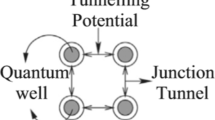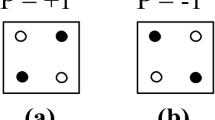Abstract
Quantum-dot cellular automata (QCA) technology is a proper alternative to CMOS circuits, which is a Nano-scale technology that is capable of designing and implementing logic circuits via high efficiency and low power. In this regard, one of the major challenges to design the circuit at QCA is the loss, addition, cells, rotation, and displacement of the cells. Some solutions have been provided to handle these challenges. In this paper, three new structures are proposed to increase the fault tolerance in the three-input majority gate. QCA Designer implements the proposed structures. The simulation results show an increase in fault tolerance and an improvement in the number of cells and space requirements.
















Similar content being viewed by others
References
Ahmadpour, S.S., Mosleh, M.: A novel fault-tolerant multiplexer in quantum-dot cellular automata technology. J. Supercomput. 74(9), 4696–4716 (2018)
Asfestani, M. N., Heikalabad S. R.: A unique structure for the multiplexer in quantum-dot cellular automata to create a revolution in design of nanostructures. Physica B: Condensed Matter 512, 91–99 (2017)
Beard, M.J.: Design and simulation of fault-tolerant quantum-dot cellular automata (QCA) NOT gates. Dissertation, Wichita State University (2006)
Chandra, J.S., Suresh, K., Ghosh, B.: Clocking scheme implementation for multi-layered quantum dot cellular automata design. J. Low Power Electron. 10(2), 272–278 (2014)
Das, K., De, D.: QCA defect and fault analysis of diverse nanostructure for implementing logic gate. Int. J. Recent Trends Eng. Technol. 3(1), 1–5 (2010)
Du, H., Lv, H., Zhang, Y., Peng, F., Xie, G.: Design and analysis of new fault-tolerant majority gate for quantum-dot cellular automata. J. Comput. Electron. 15(4), 1484–1497 (2016)
Dysart, T.J., Kogge, P.M, Lent, C.S.: An analysis of missing cell defects in quantum-dot cellular automata (2017)
Hashemi, S., Tehrani, M., Navi, K.: An efficient quantum-dot cellular automata full-adder. Sci. Res. Essays 7(2), 177–189 (2012)
Heikalabad, S. R., Asfestani M. N., Hosseinzadeh, M.: Content addressable memory cell in quantum-dot cellular automata. Microelectronic Eng. 163, 140–150 (2016)
Heikalabad, S. R., Asfestani M. N., Hosseinzadeh, M.: A full adder structure without cross-wiring in quantum-dot cellular automata with energy dissipation analysis. J. Supercomputing 74(5), 1994–2005 (2018)
Heikalabad, S. R., Salimzadeh, F., Barughi Y. Z.: A unique three-layer full adder in quantum-dot cellular automata. Comput. Electric. Eng. 86, 106735 (2020)
Hosseinzadeh, H., Heikalabad, S.R.: A novel fault tolerant majority gate in quantum-dot cellular automata to create a revolution in design of fault tolerant nanostructures, with physical verification. Microelectron. Eng. 192, 52–60 (2018)
Huang, J., Momenzadeh, M., Lombardi, F.: On the tolerance to manufacturing defects in molecular QCA tiles for processing-by-wire. J. Electron. Test. 23(2–3), 163–174 (2007). https://doi.org/10.1007/s10836-006-0548-6
Karim, F., Walus, K.: Efficient simulation of correlated dynamics in quantum-dot cellular automata (QCA). IEEE Trans. Nanotechnol. 13(2), 294–307 (2014)
Karkaj, E. T., Heikalabad S. R.: A testable parity conservative gate in quantum-dot cellular automata. Superlattices Microstruct. 101, 625–632 (2017)
Kumar, D., Mitra, D.: Design of a practical fault-tolerant adder in quantumdot cellular automata. Microelectron. J. 53, 90–104 (2016)
Lent, C.S., Tougaw, P.D., Porod, W., Bernstein, G.H.: Quantum cellular automata. Nanotechnology 4, 49–57 (1993)
Meirav, U., Kastner, M.A., Wind, S.J.: Singleelectron charging and periodic conductance resonances in GaAs nanostructures. Phys. Rev. Lett. 65(6), 771–774 (1990)
Moghimizadeh, T., Mosleh, M.: A novel design of fault-tolerant RAM cell in quantum-dot cellular automata with physical verification. J. Supercomput. 75, 5688–5716 (2019). https://doi.org/10.1007/s11227-019-02812-x
Mohammadi, M., Gorigin, S.: An efficient design of full adder in quantum-dot cellular automata technology. Microelectron. J. 50, 38–43 (2016)
Momenzadeh, M., Ottavi, M., Lombardi, F.: Modeling QCA defects at molecular-level in combinational circuits. In: 20th IEEE International Symposium on Defect and Fault Tolerance in VLSI Systems, 2005. DFT (2005)
Norouzi, M., Heikalabad, S. R., Salimzadeh, F.: A reversible ALU using HNG and Ferdkin gates in QCA nanotechnology. Int. J. Circuit Theory Appl. 48(8), 1291–1303 (2020)
Reed, M.A., Randall, J.N., Aggarwal, R.J., Matyi, R.J., Moore, T.M., Wetsel, A.E.: Observation of discrete electronic states in a zero-dimensional semiconductor nanostructure. Phys. Rev. Lett. 60, 535–539 (1988)
Roohi, A., Sayedsalehi, S., Khademolhosseini, H., Navi, K.: Design and evaluation of a reconfigurable fault tolerant quantum-dot cellular automata gate. J. Comput. Theor. Nanosci. 10, 380–388 (2013)
Roohi, A., DeMara, R.F., Khoshavi, N.: Design and evaluation of an ultra-area-efficient faulttolerant QCA full adder. Microelectron. J. 46(6), 531–542 (2015)
Salimzadeh, F., Heikalabad, S. R.: Design of a novel reversible structure for full adder/subtractor in quantum-dot cellular automata. Physica B: Condensed Matter 556, 163–169 (2019)
Salimzadeh, F., Heikalabad S. R., Gharehchopogh F. S.: Design of a reversible structure for memory in quantum‐dot cellular automata. Int. J. Circuit Theory Appl. 48(12), 2257–2265 (2020)
Sen, B., Rajoria, A., Sikdar, B.K.: Design of efficient full adder in quantum-dot cellular automata. Sci. World J. 10, 1–10 (2013)
Sen, B., et al.: Modular design of testable reversible ALU by QCA multiplexer with increase in programmability. Microelectron. J (2014). https://doi.org/10.1016/j.mejo.2014.08.012i
Sen, B., Sahu, Y., Mukherjee, R., Nath, R.K., Sikdar, B.K.: On the reliability of majority logic structure in quantum-dot cellular automata. Microelectron. J. 47, 7–18 (2016a)
Sen, B., Dutta, M., Mukherjee, R., et al.: Towards the design of hybrid QCA tiles targeting high fault tolerance. J. Comput. Electron. 15(2), 429–445 (2016b)
Sun, M., Lv, H., Zhang, Y., Xie, G.: The fundamental primitives with fault-tolerance in quantum-dot cellular automata. J. Electron. Test. 34(2), 109–122 (2018)
Tougaw, P.D., Lent, C.S.: Logical devices implemented using quantum cellular automata. J. Appl. Phys. 75(3), 1818–1825 (1994)
Walus, K., et al.: QCADesigner: a rapid design and simulation tool for quantum-dot cellular automata. IEEE Trans. Nanotechnol. 3(1), 26–31 (2004)
Wilson, M., Kannangara, K., Smith, G., Simmons, M., Raquse, B.: Nanotechnology: Basic Science and Emerging Technologies. Chapman and Hall, London (2002)
Zhang, Y., Xie, G., Han, J.: A robust wire crossing design for thermostability and fault tolerance in quantum-dot cellular automata. Microprocess. Microsyst. 74, 103033 (2020)
Author information
Authors and Affiliations
Corresponding author
Additional information
Publisher's Note
Springer Nature remains neutral with regard to jurisdictional claims in published maps and institutional affiliations.
Rights and permissions
About this article
Cite this article
Rahmani, Y., Heikalabad, S.R. & Mosleh, M. Efficient structures for fault-tolerant majority gate in quantum-dot cellular automata. Opt Quant Electron 53, 45 (2021). https://doi.org/10.1007/s11082-020-02691-0
Received:
Accepted:
Published:
DOI: https://doi.org/10.1007/s11082-020-02691-0




